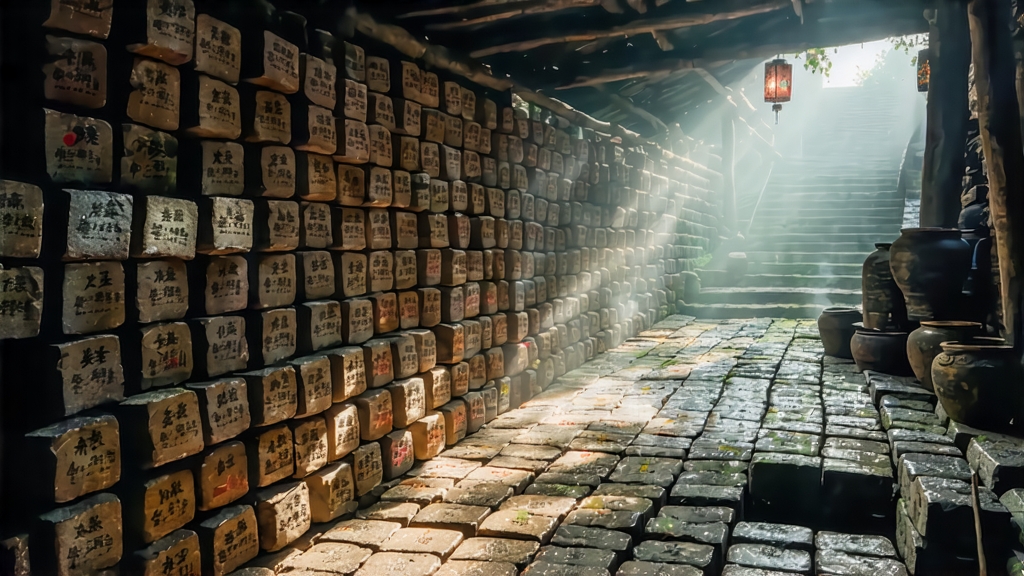
Tucked away in the humid, karst-pocked mountains of southern Guangxi, Liu Bao cha has spent the last four centuries quietly perfecting the art of time travel. What begins as a leafy spring harvest in the subtropical lowlands of Wuzhou County finishes its journey as a mahogany liquor that smells of wet camphor, betel nut and distant rain on old mahogany. To the uninitiated it is simply another Chinese dark tea; to the growers who still bind it into 40-kilo bamboo baskets and to the tea masters who guard 50-year-old cakes in subterranean caves, Liu Bao is a living manuscript of Ming-dynaste trade routes, Qing-era medicine chests and the post-war diaspora of Cantonese tea culture.
The story begins in 1585, when the port of Wuzhou opened as the westernmost customs station on the Xi River, the liquid highway that carried rice, salt and tea from the interior to Guangzhou and on to Southeast Asia. Jute-sailed junks needed a tea that would neither mildew nor lose value during the month-long voyage through the South China Sea. Locals discovered that a twice-piled, slow-fermented leaf from the Da Ye cultivar—bigger, tougher and more resinous than the tender buds favored in green-tea country—actually improved in the dank ship’s hold. By the time the cargo reached Kuala Lumpur or Jakarta, the originally grassy leaf had mellowed into a deep, sweet liquor that quenched thirst in the equatorial heat and calmed stomachs upset by ship’s biscuit and rum. Thus Liu Bao became one of China’s first truly global teas, a maritime cousin to the yak-carried bricks of Yunnan.
Yet “Liu Bao” is not a single tea but a spectrum of micro-batches distinguished by leaf grade, piling duration, basket age and the micro-climate of the final storage cave. The top tier, called “Special Flag” (te gong), is plucked in the first ten days of April when three leaves and a bud are still waxy and pale. This grade is reserved for the Hong Kong collectors who judge a tea by how many seconds the empty cup continues to exhale fragrance after the liquor is gone. One rung lower is “First Grade” (yi ji), slightly larger leaf that receives a longer wet-pile fermentation, yielding a darker, more camphoraceous cup favored by Malaysian tin-miners who drink it with condensed milk at dawn. Below that sit the sturdy “Second” and “Third Grades” that fill the bamboo baskets lining the cool corridors of the Wuzhou state warehouse, their husks stamped with the red chop “China National Native Produce” in characters unchanged since 1953.
Making Liu Bao is a dialogue between human patience and microbial opportunism. After the spring pluck, the leaves are wilted under ceiling fans for three hours, just long enough to soften cell walls without oxidizing the green away. A 200-degree drum roast follows, lasting exactly eight minutes—any longer and the leaf loses the plum-like juiciness that will later emerge during fermentation. While still warm, the leaf is piled 70 cm deep in cedar-lined troughs and misted with mineral water drawn from the Liu Bao village well, whose pH of 6.4 is considered the “sweet spot” for the local strain of Aspergillus niger. Over the next ten days the pile is turned five times, each turn spaced 36 hours apart to allow the core temperature to rise to 55 °C before oxygen is reintroduced. This first fermentation fixes the chocolate-brown color and creates the precursor molecules that will later generate Liu Bao’s signature betel-nut note.
What happens next separates Liu Bao from every other dark tea in China. Instead of being pressed immediately into cakes, the semi-fermented leaf is steamed, stuffed into forty-kilo bamboo husks woven from three-year-old mao zhu, and lashed with rattan hoops. The baskets are stacked like oversized beehives in natural limestone caves whose year-round temperature hovers between 20 and 24 °C and whose relative humidity refuses to drop below 75 %. Here the tea undergoes a second, slower fermentation that can last anywhere from two years to half a century. During this cave sleep the bamboo breathes, exchanging aromatic phenols with the leaf; the rattan slowly sugars, imparting a faint vanilla tone; and the limestone exhales calcium ions that bind to tannins, smoothing any rough